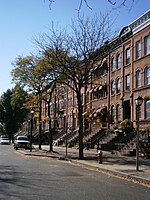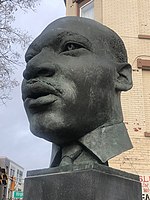Garfield Avenue station

Garfield Avenue is a station on the Hudson–Bergen Light Rail (HBLR) in the Claremont section of Jersey City, Hudson County, New Jersey. Located between the grade crossing at Randolph Avenue and the bridge at Garfield Avenue, the station in a double side platform and two track structure. The station is on the West Side Avenue branch of the Hudson–Bergen Light Rail, which goes from West Side Avenue station to Tonnelle Avenue station in North Bergen. The station is accessible for handicapped people as per the Americans with Disabilities Act of 1990. An elevator is present to get people from Garfield Avenue to track level and the platforms are even with the train cars. The station opened to the public on April 17, 2000 as part of the original operating segment of the Hudson–Bergen Light Rail.Garfield Avenue station is a block east of the former Arlington Avenue stop of the Newark and New York Railroad, a branch of the Central Railroad of New Jersey. This branch went from the Lafayette Street Terminal in Newark to the junction at Communipaw station in Jersey City, where it met up with the main line to Communipaw Terminal. Service on the line began on July 23, 1869. The station depot westbound at Arlington Avenue was built in 1889 and the eastbound station in 1910. Service to Newark ended abruptly on February 3, 1946 when a steamship knocked two spans of the bridge over the Hackensack River into the water below. Passenger service at Arlington Avenue ended on May 6, 1948.
Excerpt from the Wikipedia article Garfield Avenue station (License: CC BY-SA 3.0, Authors, Images).Garfield Avenue station
Garfield Avenue, Jersey City
Geographical coordinates (GPS) Address Nearby Places Show on map
Geographical coordinates (GPS)
| Latitude | Longitude |
|---|---|
| N 40.7105 ° | E -74.071 ° |
Address
Garfield Avenue
Garfield Avenue
07304 Jersey City
New Jersey, United States
Open on Google Maps









